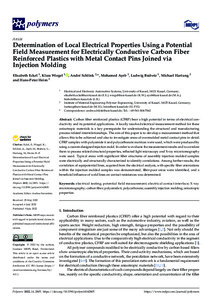| dc.date.accessioned | 2022-08-22T14:52:28Z | |
| dc.date.available | 2022-08-22T14:52:28Z | |
| dc.date.issued | 2022-07-09 | |
| dc.identifier | doi:10.17170/kobra-202208226729 | |
| dc.identifier.uri | http://hdl.handle.net/123456789/14093 | |
| dc.description.sponsorship | Gefördert durch den Publikationsfonds der Universität Kassel | ger |
| dc.language.iso | eng | |
| dc.rights | Namensnennung 4.0 International | * |
| dc.rights.uri | http://creativecommons.org/licenses/by/4.0/ | * |
| dc.subject | electrical testing | eng |
| dc.subject | potential field measurement | eng |
| dc.subject | electrical contact interface | eng |
| dc.subject | X-ray microtomography | eng |
| dc.subject | carbon fiber | eng |
| dc.subject | polyamide 6 | eng |
| dc.subject | polycarbonate | eng |
| dc.subject | assembly injection molding | eng |
| dc.subject | anisotropic properties | eng |
| dc.subject.ddc | 660 | |
| dc.title | Determination of Local Electrical Properties Using a Potential Field Measurement for Electrically Conductive Carbon Fiber Reinforced Plastics with Metal Contact Pins Joined via Injection Molding | eng |
| dc.type | Aufsatz | |
| dcterms.abstract | Carbon fiber reinforced plastics (CFRP) bear a high potential in terms of electrical conductivity and its potential applications. A locally resolved electrical measurement method for these anisotropic materials is a key prerequisite for understanding the structural and manufacturing process-related interrelationships. The aim of this paper is to develop a measurement method that allows this to be achieved and also to investigate areas of overmolded metal contact pins in detail. CFRP samples with polyamide 6 and polycarbonate matrices were used, which were produced by using a custom-designed injection mold. In order to evaluate the measurement results and to correlate them to process related structural properties, reflected light microscopy and X-ray microtomography were used. Typical areas with significant fiber structures of assembly injection molded samples were electrically and structurally characterized to identify correlations. Among further results, the correlation of equipotential lines, acquired from the electrical analysis, with specific fiber orientations within the injection molded samples was demonstrated, fiber-poor areas were identified, and a beneficial influence of weld lines on contact resistances was determined. | eng |
| dcterms.accessRights | open access | |
| dcterms.creator | Eckel, Elisabeth | |
| dcterms.creator | Wiegel, Klara | |
| dcterms.creator | Schlink, André | |
| dcterms.creator | Ayeb, Mohamed | |
| dcterms.creator | Brabetz, Ludwig | |
| dcterms.creator | Hartung, Michael | |
| dcterms.creator | Heim, Hans-Peter | |
| dc.relation.doi | doi:10.3390/polym14142805 | |
| dc.subject.swd | Kunststofftechnik | ger |
| dc.subject.swd | Kohlenstofffaserverstärkter Kunststoff | ger |
| dc.subject.swd | Elektrische Leitfähigkeit | ger |
| dc.subject.swd | Kohlenstofffaser | ger |
| dc.subject.swd | Polyamid 6 | ger |
| dc.subject.swd | Spritzgießen | ger |
| dc.type.version | publishedVersion | |
| dcterms.source.identifier | eissn:2073-4360 | |
| dcterms.source.issue | Issue 14 | |
| dcterms.source.journal | Polymers | eng |
| dcterms.source.volume | Volume 14 | |
| kup.iskup | false | |


